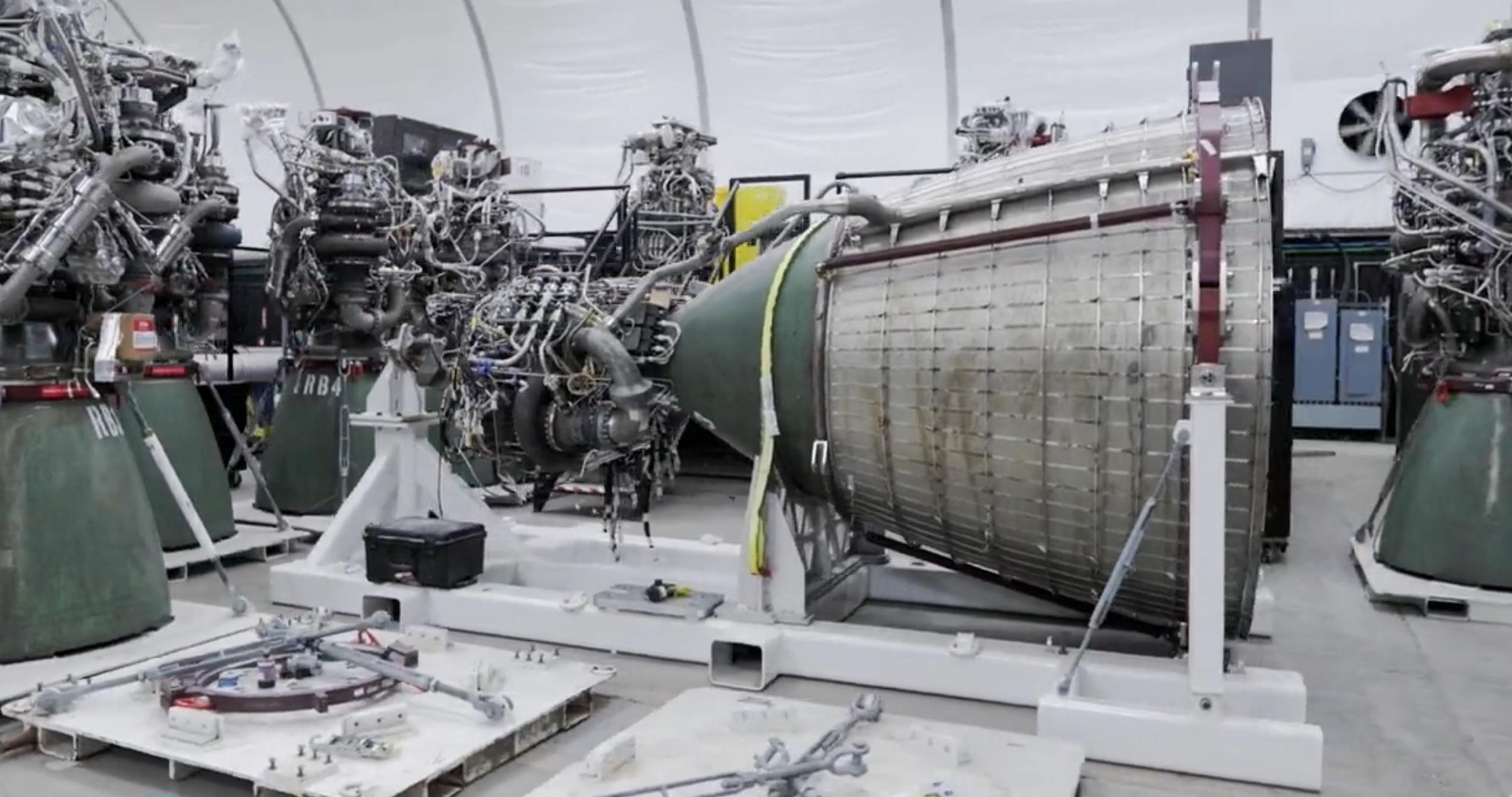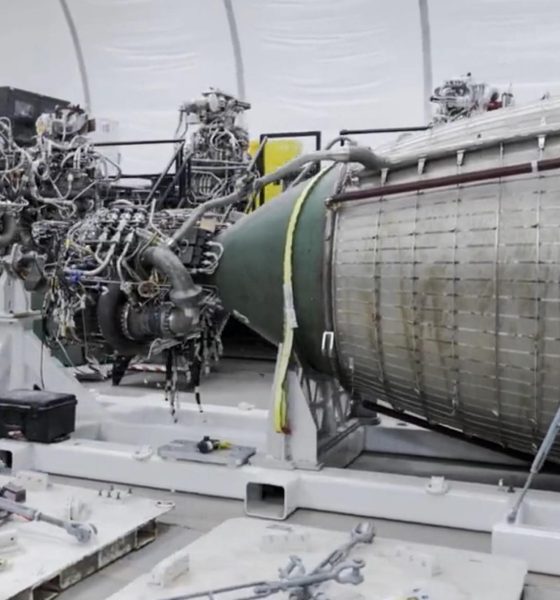

News
SpaceX rolls Raptor Vacuum engines to launch pad for Starship’s next tests
For the second time, SpaceX is gearing up to install a full six Raptor engines on the first orbital-class Starship prototype.
This time around, though, there’s reason to believe that the preparations SpaceX is making aren’t a false start and could culminate in one or several record-breaking Starship static fires as early as next week.
SpaceX installed Raptors on Starship S20 for the first time in early August, outfitting the 50m (165 ft) tall prototype with a full six engines as part of a fit test that ultimately saw it installed on top of a Super Heavy booster. Ship 20 only spent an hour on top of Booster 4, though, and was quickly returned to Starbase build site for Raptor removal and final outfitting. Ship 20 was then rolled back to the launch site and installed on one of two suborbital launch mounts and test stands in mid-August, where it has sat ever since.
Between September 4th and 10th, SpaceX then appeared to install three sea-level-optimized Raptor Center (RC) engines and one Raptor Vacuum (RVac) engine on Starship S20 before the prototype had completed any proof testing. Whether that set of installs was a fit test or an aborted attempt at full installation, SpaceX seemingly paused at three or four Raptors and ultimately removed the lone RVac and one or more of S20’s sea-level engines. Another sea-level Raptor was (re)installed on September 15th.
After a frenetic month of back and forth with no obvious rhyme or reason, all of Ship 20’s Raptors were removed and a series of hydraulic rams used to simulate engine thrust – removed, unused, back in August – were reinstalled. Starship then completed pneumatic and cryogenic proof tests in the last few days of September.

After another ten or so days of unusual downtime, SpaceX began reinstalling Raptors on Ship 20 – one sea-level and one vacuum – around October 10th for a static fire test campaign that began about a week later. Finally, on October 21st, SpaceX fired up the orbital-class prototype for the first time, also completing the first test of a Raptor Vacuum engine installed on a Starship. Barely an hour later, Starship S20 performed a second test, simultaneously firing up both RVac and RC engine in another first.
Barely a full day after that successful back-to-back static fire test, SpaceX rolled two more sea-level Raptors to the suborbital pad and installed them on Ship 20. Another unusual week of downtime later and, on October 28th, SpaceX has rolled two more Raptor Vacuum engines from the build site to the launch pad and staged them beside Starship. Once installed, Starship S20 will, for the second time, be fully outfitted with six Raptors. Having already fired up two of those engines without needing either replaced, though, there’s a decent chance that all six will actually be used before Ship 20’s next bout of engine removal/installation deja vu.
SpaceX has never fired more than three engines at a time on a Starship prototype or at its suborbital test site, so a number of firsts potentially lay before Ship 20 as it nears a second round of static fire testing. There is some uncertainty as to whether the suborbital test stands can actually handle the stress from static fires with more than three Raptors, but if they can, then S20 will likely be the first prototype to ignite more 4+ engines and could become the first Starship to fire all six engines at once.
SpaceX currently has one possible test window scheduled from 10am to 6pm CDT on Monday, November 1st, though it could be another week or more before Starship S20’s next static fire attempt if past trends continue.

News
Tesla Model 3 becomes Netherlands’ best-selling used EV in 2025
More than one in ten second-hand electric cars sold in the country last year was a Tesla Model 3.

The Tesla Model 3 became the most popular used electric car in the Netherlands in 2025, cementing its dominance well beyond the country’s new-car market.
After years at the top of Dutch EV sales charts, the Model 3 now leads the country’s second-hand EV market by a wide margin, as record used-car purchases pushed electric vehicles further into the mainstream.
Model 3 takes a commanding lead
The Netherlands recorded more than 2.1 million used car sales last year, the highest level on record. Of those, roughly 4.8%, or about 102,000 vehicles, were electric. Within that growing segment, the Tesla Model 3 stood far ahead of its competitors.
In 2025 alone, 11,338 used Model 3s changed hands, giving the car an 11.1% share of the country’s entire used EV market. That means more than one in ten second-hand electric cars sold in the country last year was a Tesla Model 3, Auto Week Netherlands reported. The scale of its lead is striking: the gap between the Model 3 and the second-place finisher, the Volkswagen ID3, is more than 6,700 vehicles.
Rivals trail as residual values shape rankings
The Volkswagen ID.3 ranked a distant second, with 4,595 used units sold and a 4.5% market share. Close behind was the Audi e-tron, which placed third with 4,236 registrations. As noted by Auto Week Netherlands, relatively low residual values likely boosted the e-tron’s appeal in the used market, despite its higher original price.
Other strong performers included the Kia Niro, the Tesla Model Y, and the Hyundai Kona, highlighting continued demand for compact and midsize electric vehicles with proven range and reliability. No other model, however, came close to matching the Model 3’s scale or market presence.
News
Tesla Model Y Standard Long Range RWD launches in Europe
The update was announced by Tesla Europe & Middle East in a post on its official social media account on X.

Tesla has expanded the Model Y lineup in Europe with the introduction of the Standard Long Range RWD variant, which offers an impressive 657 km of WLTP range.
The update was announced by Tesla Europe & Middle East in a post on its official social media account on X.
Model Y Standard Long Range RWD Details
Tesla Europe & Middle East highlighted some of the Model Y Standard Long Range RWD’s most notable specs, from its 657 km of WLTP range to its 2,118 liters of cargo volume. More importantly, Tesla also noted that the newly released variant only consumes 12.7 kWh per 100 km, making it the most efficient Model Y to date.
The Model Y Standard provides a lower entry point for consumers who wish to enter the Tesla ecosystem at the lowest possible price. While the Model 3 Standard is still more affordable, some consumers might prefer the Model Y Standard due to its larger size and crossover form factor. The fact that the Model Y Standard is equipped with Tesla’s AI4 computer also makes it ready for FSD’s eventual rollout to the region.
Top Gear’s Model Y Standard review
Top Gear‘s recent review of the Tesla Model Y Standard highlighted some of the vehicle’s most notable features, such as its impressive real-world range, stellar infotainment system, and spacious interior. As per the publication, the Model Y Standard still retains a lot of what makes Tesla’s vehicles well-rounded, even if it’s been equipped with a simplified interior.
Top Gear compared the Model Y Standard to its rivals in the same segment. “The introduction of the Standard trim brings the Model Y in line with the entry price of most of its closest competition. In fact, it’s actually cheaper than a Peugeot e-3008 and costs £5k less than an entry-level Audi Q4 e-tron. It also makes the Ford Mustang Mach-E look a little short with its higher entry price and worse range,” the publication wrote.
Elon Musk
Elon Musk’s xAI bets $20B on Mississippi with 2GW AI data center project
The project is expected to create hundreds of permanent jobs, dramatically expand xAI’s computing capacity, and further cement the Mid-South as a growing hub for AI infrastructure.

Elon Musk’s xAI plans to pour more than $20 billion into a massive new data center campus in Southaven, Mississippi, marking the largest single economic development project in the state’s history.
The project is expected to create hundreds of permanent jobs, dramatically expand xAI’s computing capacity, and further cement the Mid-South as a growing hub for AI infrastructure.
xAI goes MACROHARDRR in Mississippi
xAI has acquired and is retrofitting an existing facility in Southaven to serve as a new data center, which will be known as “MACROHARDRR.” The site sits near a recently acquired power plant and close to one of xAI’s existing data centers in Tennessee, creating a regional cluster designed to support large-scale AI training and inference.
Once completed, the Southaven facility is expected to push the company’s total computing capacity to nearly 2 GW, placing it among the most powerful AI compute installations globally. The data center is scheduled to begin operations in February 2026.
Gov. Tate Reeves shared his optimism about the project in a press release. “This record-shattering $20 billion investment is an amazing start to what is sure to be another incredible year for economic development in Mississippi. Today, Elon Musk is bringing xAI to DeSoto County, a project that will transform the region and bring amazing opportunities to its residents for generations. This is the largest economic development project in Mississippi’s history,” he said.
xAI’s broader AI ambitions
To secure the investment, the Mississippi Development Authority approved xAI for its Data Center Incentive program, which provides sales and use tax exemptions on eligible computing hardware and software. The City of Southaven and DeSoto County are also supporting the project through fee-in-lieu agreements aimed at accelerating development timelines and reducing upfront costs.
Founded in 2023 by Elon Musk, xAI develops advanced artificial intelligence systems focused on large-scale reasoning and generative applications. Its flagship product, Grok, is integrated with the social media platform X, alongside a growing suite of APIs for image generation, voice, and autonomous agents, including offerings tailored for government use.
Elon Musk highlighted xAi’s growth and momentum in a comment about the matter. “xAI is scaling at an immeasurable pace — we are building our third massive data center in the greater Memphis area. MACROHARDRR pushes our Colossus training compute to ~2GW – by far the most powerful AI system on Earth. This is insane execution speed by xAI and the state of Mississippi. We are grateful to Governor Reeves for his support of building xAI at warp speed,” Musk said.








